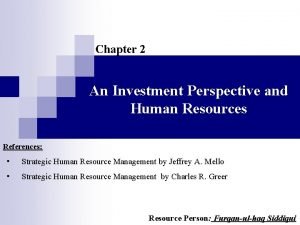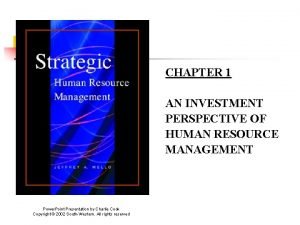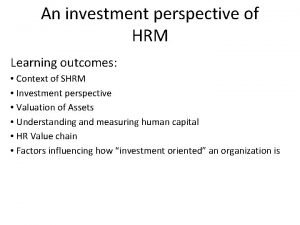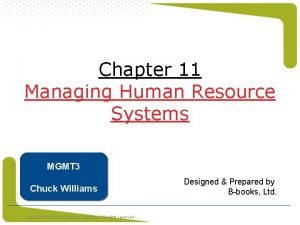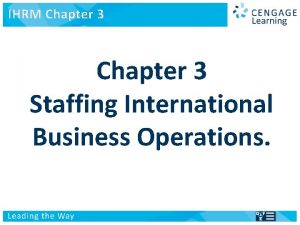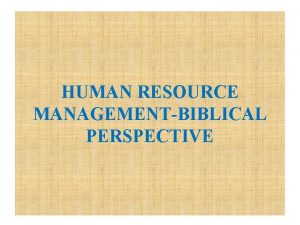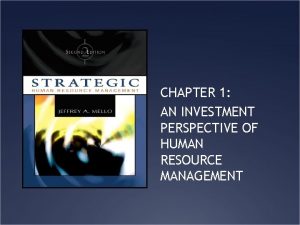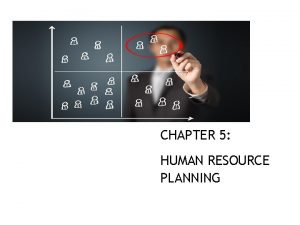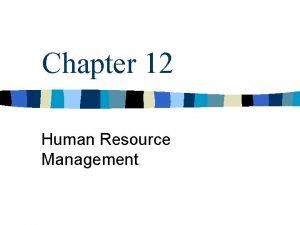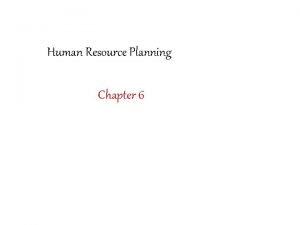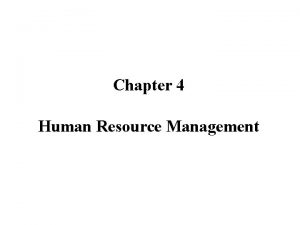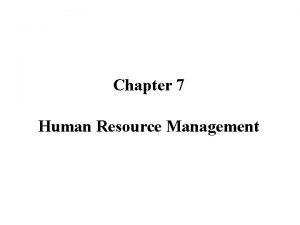CHAPTER 1 AN INVESTMENT PERSPECTIVE OF HUMAN RESOURCE











- Slides: 11

CHAPTER 1 AN INVESTMENT PERSPECTIVE OF HUMAN RESOURCE MANAGEMENT Power. Point Presentation by Charlie Cook Copyright © 2002 South-Western. All rights reserved

The Strategic View of Human Resources • Employees are human assets that increase in value to the organization and the marketplace when investments of appropriate policies and programs are applied. • Effective organizations recognize that their employees do have value, much as same as the organization’s physical and capital assets have value. • Employees are a valuable source of sustainable competitive advantage. Copyright © 2002 South-Western. All rights reserved. 2

Copyright © 2002 South-Western. All rights reserved.

Sources of Employee Value • Technical Knowledge – Markets, Processes, Customers, Environment • Ability to Learn and Grow – Openness to new ideas – Acquisition of knowledge and skills • • Decision Making Capabilities Motivation Commitment Teamwork – Interpersonal skills, Leadership ability Copyright © 2002 South-Western. All rights reserved. 4

Valuation of Human Assets • Implications for Individuals and Organizations – Determination of compensation • Internal and external equity for employees in return for their contributions to the organization. • Organization placement of resources and returns on employee development are aligned and well-matched. – Advancement opportunities • Developing current employees creates motivation and permits promotion from within. – Development of retention strategies • Effective means of retaining valuable employees allows for the recapture of the invested costs of their development. Copyright © 2002 South-Western. All rights reserved. 5

Investment Orientation Copyright © 2002 South-Western. All rights reserved. 6

The Investment-Oriented Organization • Organizational Characteristics – Sees people as central to its mission/strategy. – Has a mission statement and strategic objectives that espouse the value of human assets in achieving goals. – Has a management philosophy that encourages the development and retention of human assets and does not treat or regard human assets in the same ways as physical assets. Copyright © 2002 South-Western. All rights reserved. 7

Investment Orientation Factors • Senior Management Values and Actions – An organization’s willingness to invest in its human resources is determined by the “investment orientation” of its managers. • Attitude Toward Risk – Investment in human resources is inherently riskier due to lack of absolute “ownership” of the asset. • Nature of Skills Needed by Employees – The more likely that skills developed by employees are marketable outside the firm, the more risky the firm’s investment in the Copyright © 2002 South-Western. All rights reserved. development of those skills. 8

Investment Orientation Factors • Utilitarian (“Bottom Line”) Mentality – An attempt is made to quantify employee worth to the organization through a cost-benefit analysis. – The “soft” benefits of HR programs and polices are difficult to objectively quantify because they affect many different organizational areas and have differential effects on individual employees. • Availability of Outsourcing – If cost-effective outsourcing is available, investments will be made only in HR activities producing the highest returns and largest sustainable competitive advantages. Copyright © 2002 South-Western. All rights reserved. 9

Reading 1. 1: The SWA Value Cycle Value at Southwest Airlines is: 1. Created through satisfaction of employee needs. 2. Converted to customer and share holder value via organizational capabilities (the design of specific operating processes). 3. Captured by SWA as competitive advantage through lower costs and superior service (productivity) in relation to its competitors. Copyright © 2002 South-Western. All rights reserved. 10

Reading 1. 2: Effective HRM Practices • • Employment Security Selectivity in Recruiting High Wages Incentive pay Employee Ownership Information Sharing Participation & Ownership • Self-Managed Teams Copyright © 2002 South-Western. All rights reserved. • Training & Development • Cross-Utilization & Cross -Training • Symbolic Egalitarianism • Wage Compression • Promotion From Within • Taking the Long View • Measurement of Practice • Overall Philosophy 11
 Investment orientation
Investment orientation Investment perspective of human resource management
Investment perspective of human resource management Fixed investment and inventory investment
Fixed investment and inventory investment Investment perspective of shrm
Investment perspective of shrm Chapter 2 human resource management
Chapter 2 human resource management Chapter 9 human resource management
Chapter 9 human resource management Chapter 11 human resource management
Chapter 11 human resource management Chapter 1 introduction to human resource management
Chapter 1 introduction to human resource management Intro to human resource management
Intro to human resource management Management fifteenth edition
Management fifteenth edition Human resource management lecture chapter 1
Human resource management lecture chapter 1 Determinants of staffing choices
Determinants of staffing choices
